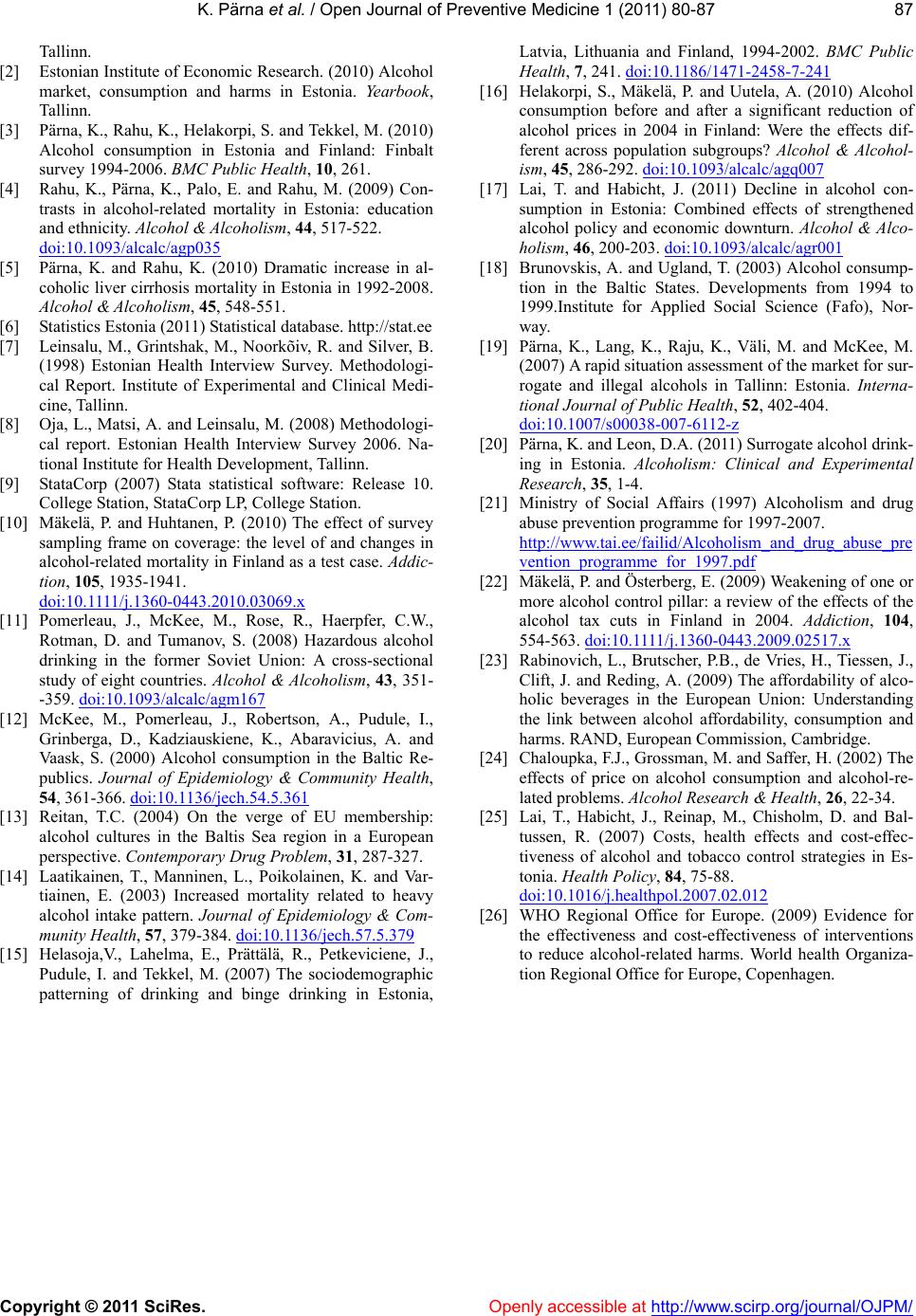
K. Pärna et al. / Open Journal of Preventive Medicine 1 (2011) 80-87
Copyright © 2011 SciRes. http://www.scirp.org/journal/OJPM/Openly accessible at
87
Tallinn.
[2] Estonian Institute of Economic Research. (2010) Alcohol
market, consumption and harms in Estonia. Yearbook,
Tallinn.
[3] Pärna, K., Rahu, K., Helakorpi, S. and Tekkel, M. (2010)
Alcohol consumption in Estonia and Finland: Finbalt
survey 1994-2006. BMC Public Health, 10, 261.
[4] Rahu, K., Pärna, K., Palo, E. and Rahu, M. (2009) Con-
trasts in alcohol-related mortality in Estonia: education
and ethnicity. Alcohol & Alcoholism, 44, 517-522.
doi:10.1093/alcalc/agp035
[5] Pärna, K. and Rahu, K. (2010) Dramatic increase in al-
coholic liver cirrhosis mortality in Estonia in 1992-2008.
Alcohol & Alcoholism, 45, 548-551.
[6] Statistics Estonia (2011) Statistical database. http://stat.ee
[7] Leinsalu, M., Grintshak, M., Noorkõiv, R. and Silver, B.
(1998) Estonian Health Interview Survey. Methodologi-
cal Report. Institute of Experimental and Clinical Medi-
cine, Tallinn.
[8] Oja, L., Matsi, A. and Leinsalu, M. (2008) Methodologi-
cal report. Estonian Health Interview Survey 2006. Na-
tional Institute for Health Development, Tallinn.
[9] StataCorp (2007) Stata statistical software: Release 10.
College Station, StataCorp LP, College Station.
[10] Mäkelä, P. and Huhtanen, P. (2010) The effect of survey
sampling frame on coverage: the level of and changes in
alcohol-relate d mortality in Finland as a test case. Addic-
tion, 105, 1935-1941.
doi: 10.1111/j .1 360-0443.2010.03069.x
[11] Pomerleau, J., McKee, M., Rose, R., Haerpfer, C.W.,
Rotman, D. and Tumanov, S. (2008) Hazardous alcohol
drinking in the former Soviet Union: A cross-sectional
study of eight countries. Alcohol & Alcoholism, 43, 351-
-359. doi:10.1093/alcalc/agm167
[12] McKee, M., Pomerleau, J., Robertson, A., Pudule, I.,
Grinberga, D., Kadziauskiene, K., Abaravicius, A. and
Vaask, S. (2000) Alcohol consumption in the Baltic Re-
publics. Journal of Epidemiology & Community Health,
54, 361-366. doi:10.1136/jech.54.5.361
[13] Reitan, T.C. (2004) On the verge of EU membership:
alcohol cultures in the Baltis Sea region in a European
perspective. Contemporary Drug Problem, 31, 287-327.
[14] Laatikainen, T., Manninen, L., Poikolainen, K. and Var-
tiainen, E. (2003) Increased mortality related to heavy
alcohol intake pattern. Journal of Epidemiology & Com-
munity Health, 57, 379-384. doi:10.1136/jech.57.5.379
[15] Helasoja,V., Lahelma, E., Prättälä, R., Petkeviciene, J.,
Pudule, I. and Tekkel, M. (2007) The sociodemographic
patterning of drinking and binge drinking in Estonia,
Latvia, Lithuania and Finland, 1994-2002. BMC Public
Health, 7, 241. doi:10.1186/1471-2458-7-241
[16] Helakorpi, S., Mäkelä, P. and Uutela, A. (2010) Alcohol
consumption before and after a significant reduction of
alcohol prices in 2004 in Finland: Were the effects dif-
ferent across population subgroups? Alcohol & Alcohol-
ism, 45, 286-292. doi:10.1093/alcalc/agq007
[17] Lai, T. and Habicht, J. (2011) Decline in alcohol con-
sumption in Estonia: Combined effects of strengthened
alcohol policy and economic downturn. Alcohol & Alco-
holism, 46, 200-203. doi:10.1093/alcalc/agr001
[18] Brunovskis, A. and Ugland, T. (2003) Alcohol consump-
tion in the Baltic States. Developments from 1994 to
1999.Institute for Applied Social Science (Fafo), Nor-
way.
[19] Pärna, K., Lang, K., Raju, K., Väli, M. and McKee, M.
(2007) A rapid situation assessment of the market for sur-
rogate and illegal alcohols in Tallinn: Estonia. Interna-
tional Journal of Public Health, 52, 402-404.
doi:10.1007/s00038-007-6112-z
[20] Pärna, K. and Leon, D.A. (2011) Surrogate alcohol drink -
ing in Estonia. Alcoholism: Clinical and Experimental
Research, 35, 1-4.
[21] Ministry of Social Affairs (1997) Alcoholism and drug
abuse prevention programme for 1997-2007.
http://www.tai.ee/failid/Alcoholism_and_drug_abuse_pre
vention_programme_for_1997.pdf
[22] Mäkelä, P. and Österberg, E. (2009) Weakening of one or
more alcohol control pillar: a review of the effects of the
alcohol tax cuts in Finland in 2004. Addiction, 104,
554-563. doi:10.1111/j. 1360-0443.2009.02517.x
[23] Rabinovich, L., Brutscher, P.B., de Vries, H., Tiessen, J.,
Clift, J. and Reding, A. (2009) The affordability of alco-
holic beverages in the European Union: Understanding
the link between alcohol affordability, consumption and
harms. RAND, European Commission, Cambridge.
[24] Chaloupka, F.J., Grossman, M. and Saffer, H. (2002) The
effects of price on alcohol consumption and alcohol-re-
lated problems. Alcohol Research & Health, 26, 22-34.
[25] Lai, T., Habicht, J., Reinap, M., Chisholm, D. and Bal-
tussen, R. (2007) Costs, health effects and cost-effec-
tiveness of alcohol and tobacco control strategies in Es-
tonia. Health Policy, 84, 75-88.
doi:10.1016/j.healthpol.2007.02.012
[26] WHO Regional Office for Europe. (2009) Evidence for
the effectiveness and cost-effectiveness of interventions
to reduce alcohol-related harms. World health Organiza-
tion Regional Office for Europe, Copenhagen.